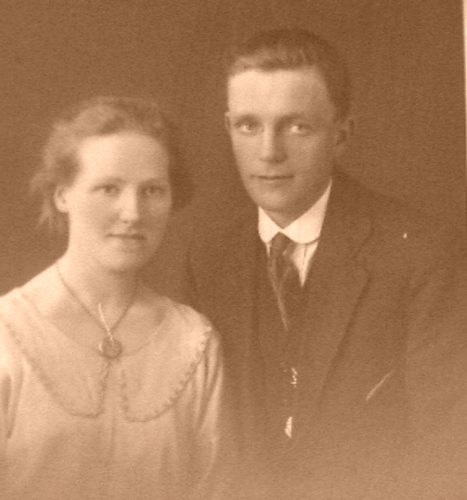Derbyshire Times, Saturday, June 25, 1932
Quarryman killed by Crane
|
An Ill-Fated Wirksworth Family
| |
This picture shows the collapsed Crane,
which killed A.McIntyre, Wirksworth
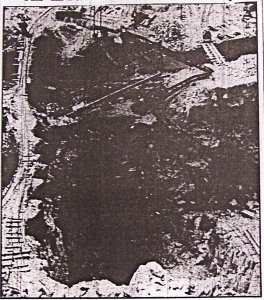 |
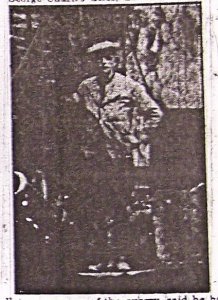 |
Mr Alfred Ambrose McIntyre (35),
Wirksworth, was killed while at work in
Hopton Wood Quarry, Via Gellia, belonging
to Hopton Wood Stone Firms, Ltd, on
Tuesday.
He was a steam crane driver and had
gone to relieve Mr Mark Brewell, who a
few days before had met with an accident
on his way to work. About 11 am
there was a crane mishap and McIntyre
was killed instantly.
William Wetton (31), Gorsey Bank,
Wirksworth, deceased's brother-in-law,
was killed about 12 months ago when a
box hanging from the same crane knocked
him from the quarry face.
Jack McIntyre, brother of Alfred
McIntyre, lives at Greenhill with a broken
back sustained in a quarry accident some
four or five years ago.
Mr Alfred McIntyre joined the Matlock
Terretorials in 1914 and served four years
in France, where he received a certificate
for efficiency as a crane driver. He was
organist at Wirksworth P.M. Church. His
mother and father live at Dale Street,
Wirksworth
The inquest, held at Wirksworth Cottage
Hospital on Wednesday by the District
Coroner (Mr S.Taylor), was attended by
H M Inspector of Mines (Mr Hall), Mr
W Foster, Nottingham, representing the
Hopton Wood Stone Firms Ltd, and Mr
John Cooper, the National Union of
General Workers.
Ambrose McIntyre, The Dale, Wirksworth,
labourer, father of the deceased, gave
evidence of identification.
Leonard Spencer, a trammer, employed
by the Hopton Wood Stone Firms, residing
at Bolehill, said he spoke to McIntyre
about 10.15 am, and gave him a cigarette.
He left the crane to tip a wagon,
and he then saw the jib falling. He looked
but could see nothing
for steam. He tried to turn the steam off,
but it was impossible.
Ernest Wheeldon, engine driver,
employed at the quarry, and residing at
Hillside, Middleton-by-Wirksworth, said he
arrived immediately after the accident.
McIntyre was lying in a huddled position
with his head near the crane boiler door.
His left foot was fast, and he did not
appear to be alive. He (witness) extricated
him with assistance, and the body was
removed to the mortuary.
William Ashmore, Cromford, deputy
engineer at the quarry, said McIntyre
worked on a crane which had a straight
support in the centre, two "guys" and a
jib. It was erected five years ago and
it was then second hand. The crane was
examined every morning and the top was
inspected twice a week.
Witness last examined the top of the
crane on Friday and it was due to be
examined again on the day of the accident.
It was perfect on Friday.
The cause of the accident was a clean
break of the "strap" - it had snapped off
like a carrot. The "strap" was five
inches wide and two and a half inches
thick and there was a hole in the centre.
Answering Mr Hall, witness said the
strap had never been taken off the crane
to his knowledge. The crane was designed
to lift five tons, and the load on it at the
time of the accident was about two tons,
10 cwts. There was no reason for any
extra strain about this time.
In reply to Mr Cooper, witness said if
the strap gave way the crane collapsed.
The strap was supposed to last the lifetime
of the crane.
The strap, added the witness, was fully up
to its work. The cause of the accident
was the crystalisation of the strap, and
there was no way of detecting it.
The Coroner: Supposing that piece had
been taken off, could it have been
detected?'
Witness: No, sir. It was inside.
Answering Mr Harrison (forman of the
jury), witness said there was a bolt hole
at the exact point where the strap
snapped.
Mr Hall told the Coroner that in some
important instances annealing was necessary
every six months in order to stop
crystalisation, but he could not say
whether this regulation applied to cranes.
Henry Slack, quarryman, New road,
Middleton, said he was working in the
bottom of the quarry beneath the crane.
He saw the crane hauling up a box of
about two tons of stone, and the jib was
not extended very far. He saw the whole
crane moving, and he shouted "The
crane's tumbling over". The load had
been raised about 40 feet when the crane
crashed over.
George Charles Giles, The Laurels, Middleton,
manager of the quarry, said he had
never heard of annealing crane straps.
There would be more danger in taking
down and putting up cranes for annealing
purposes then there was of an accident
of that sort. He had never heard of one
before.
Dr E D Broster said that the deceased's
neck was broken. There were other
injuries, but no burning. Death would be
practically instantaneous.
The Coroner said the accident was
undoubtedly due to cristalisation in the
steel strap, a flaw that was invisible and
could only be cured by annealing.
The jury returned a verdict of "Accidental Death".
Mr Foster said that he was particularly
requested to say that the Hopton Firms
deplored the loss of a workman who bore
a very high character.
Mr Cooper associated himself with this
expression, and said that was, unfortunately,
the third case which had come
before his Union from that family.
|
|
John Edward McIntyre
From the High Peak News dated 28 Jan 1925
Accident at
Hopton Wood Stone Quarry, Wirksworth
'Mr John McIntyre, a quarryman at the Hopton Wood quarries of the Hopton
Wood Stone Firms Ltd met with a serious accident on Wednesday morning last.
Mr McIntyre was quarrying stone at the face of the rock when a piece of
stone he liberated struck him heavily in the back and almost knocked him off
the ledge on which he was working about 30 feet from the bottom of the
quarry. He was rescued from his precarious position by his fellow-workmen
and after first aid was conveyed to the Cottage Hospital Wirksworth.
On making enquiries later we (the newspaper) were informed that Mr McIntyre's
condition is regarded as critical.'
A report in the
Derby Daily Express dated 29 Jan 1925 reported,
'The condition of Mr Jack McIntyre of The Dale Wirksworth who was
admitted to the Derby Royal Infirmary on Thursday suffering from a
broken back is reported to be unchanged.'
Jack McIntyre's wheelchair is on the Prince's left.
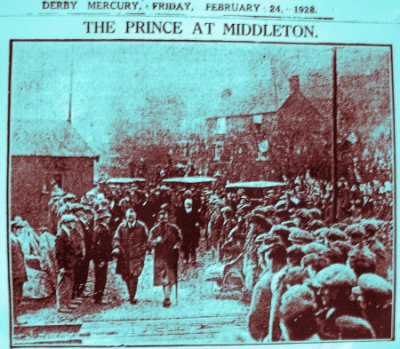
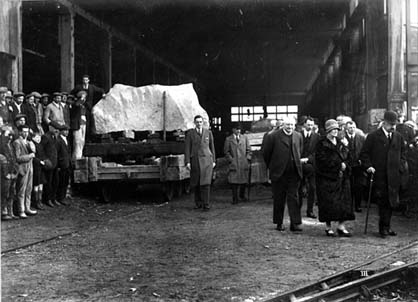
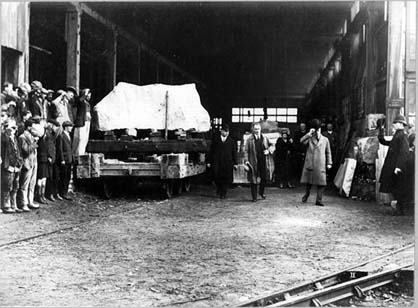
During the visit of Prince Edward VIII at Hopton Wood Stone quarry
Wirksworth of particular interest was the production of headstones
by the company for the Imperial War Graves Commission. Over a six year
period the company produced 10,000 headstones using a specially constructed
pantograph machine which could be operated by unskilled and disabled people
alike. An extract from the account on the Royal Visit being covered
by the
High Peak News on 21 Feb 1928 reads
'Sympathy With Ex-Soldier
The Prince had a chat with Mr J McIntyre, an
employee of the firm who sustained injuries to his spine as the result of
an accident at the Hopton Wood quarries several years ago. His Royal
Highness expressed sympathy with McIntyre, remarking that it was most
unfortunate that he should have served throughout the War without a
scratch and then met with an accident of this nature'.
|
|
